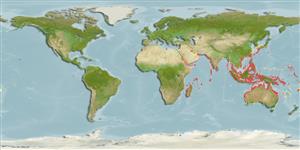Malacostraca |
Decapoda |
Diogenidae
Environment: milieu / climate zone / Mức độ sâu / distribution range
Sinh thái học
; Thuộc về nước lợ. Tropical
Indo-West Pacific.
Length at first maturity / Bộ gần gũi / Weight / Age
Chín muồi sinh dục: Lm ? range ? - ? cm
Very common in mangrove areas (Ref. 81754). Estuarine or brackish, intertidal (Ref. 106854). Feeds by means of both micro and macrofeeding. That is, it filter feeds, trapping microorganisms. It deposit feeds, utilizing detritus. As macrofeeder, it mainly depends on green algae, barnacles and worms (Ref. 108395). Discretely motile (Ref. 125928).
Life cycle and mating behavior
Chín muồi sinh dục | Sự tái sinh sản | Đẻ trứng | Eggs | Sự sinh sản | Larvae
Members of the order Decapoda are mostly gonochoric. Mating behavior: Precopulatory courtship ritual is common (through olfactory and tactile cues); usually indirect sperm transfer.
Rahayu, D.L. 2000 Hermit crabs from the South China Sea (Crustacea: Decapoda: Anomura: Diogenidae, Paguridae, Parapaguridae). The Raffles Bulletin of Zoology 8:377-404. (Tài liệu tham khảo 81753)
IUCN Red List Status
(Tài liệu tham khảo 130435: Version 2025-1)
CITES status (Tài liệu tham khảo 108899)
Not Evaluated
CMS (Tài liệu tham khảo 116361)
Not Evaluated
Threat to humans
Harmless
Human uses
| FishSource |
Các công cụ
Thêm thông tin
Population dynamicsSự sinh trưởng
Max. ages / sizes
Length-weight rel.
Length-length rel.
Length-frequencies
Mass conversion
Sự phong phú
PhysiologyThành phần ô-xy
Human RelatedStamps, coins, misc.
Các nguồn internet
Estimates based on models
Preferred temperature
(Ref.
115969): 24.7 - 29.2, mean 28.5 (based on 1727 cells).
